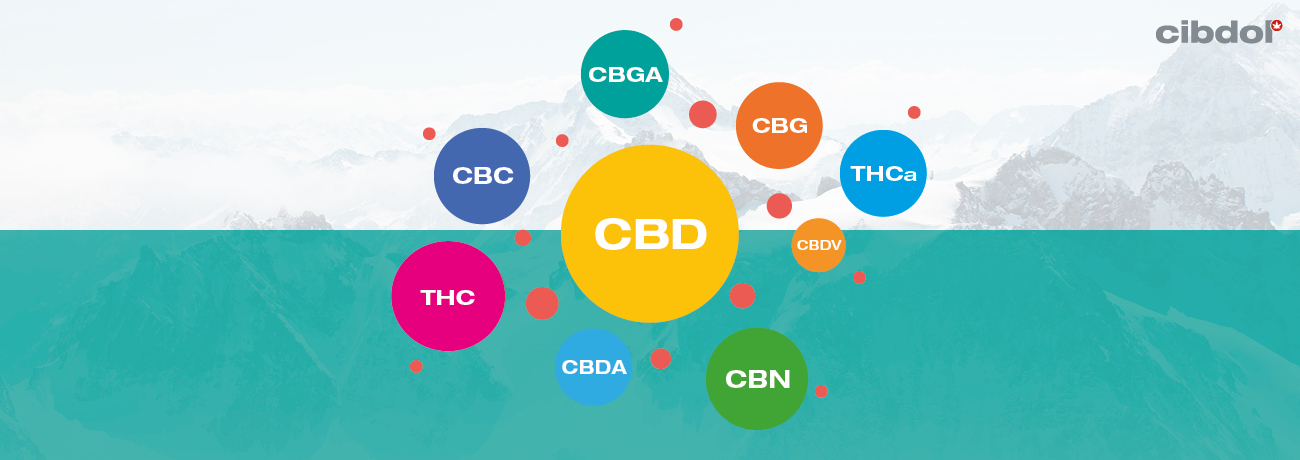What Is Full-Spectrum CBD Oil?

Full-spectrum CBD oil makes use of more than just two cannabinoids, and more than cannabinoids in general. They harness the power of a diverse array of cannabis constituents to create more effective and versatile formulas. Continue reading to find out more about it, and why it's often superior to other forms of CBD extracts.
Contents:
WHAT IS FULL-SPECTRUM CBD OIL?
Full-spectrum CBD oil utilises all of the important molecules produced by the cannabis plant. These formulas feature a rich blend of cannabinoids, terpenes, flavonoids, and even trace minerals and vitamins.
Cannabinoids—namely CBD—are the main component in full-spectrum oils. However, researchers have identified over 100 members of this chemical class within the plant. As opposed to isolated products, full-spectrum incorporates small amounts of “minor” cannabinoids, including:
• CBG
• CBC
• THC (depends)
• THCV
• CBN
Research continues to uncover the unique and fascinating ways these molecules work in isolation[1], yet studies show that full-spectrum CBD oils often work better[2] than single-compound formulas. Why? Scientists propose that cannabinoids synergise with each other to produce more effective results—a phenomenon known as the entourage effect[3].
WHY ARE TERPENES AND FLAVONOIDS IMPORTANT?
Cannabinoids aren’t the only molecules that take part in this symbiotic chemical symphony. The cannabis plant also produces in excess of 200 terpenes and an array of flavonoids that contribute to the overarching effects of full-spectrum CBD oil. Some of these molecules may enhance the action of certain cannabinoids, while others are believed to exert complementary effects.
Terpenes underpin the signature scent of the cannabis plants, endowing some cultivars with pungent aromas of earthiness and pine, and others with smells of sweetness and fruit.
Aside from their pleasant influence on the olfactory system, terpenes also modulate the effects of cannabinoids on the body. Although most cannabis strains contain similar levels of THC or CBD, they each produce distinct effects—we have terpenes to thank for this.
For example, the common terpene myrcene produces a soothing sensation[4], whereas limonene exerts uplifting qualities. These terpenes interact with cannabinoids such as THC and CBD to effectively amplify their properties[5].
Full-spectrum CBD oils also pull flavonoids into the equation, adding another complementary element to the complex entourage effect. Flavonoids make up another broad class of molecules found in cannabis. Praised for their nourishing role in a wide range of fruits and vegetables, these chemicals add another notch to cannabis' botanical belt.
These include flavonoids unique to cannabis—cannflavin A, B, and C—which appear in aerial portions of the plant, as well as flavonoids found elsewhere in the plant kingdom, including:
• Orientin
• Quercetin
• Silymarin
• Kaempferol

CAN FULL-SPECTRUM CBD OIL BE THC-FREE?
Most CBD products stem from hemp, a type of industrial cannabis extremely low in THC. In fact, European hemp must clock in at less than 0.2% THC in order to be used to create CBD oil.
The definition of “full-spectrum” changes slightly depending on the manufacturer. Some companies refer to CBD oils with negligible amounts of THC as full-spectrum, and those with no presence of THC at all as “broad-spectrum”.
IS FULL-SPECTRUM CBD OIL BETTER?
Full-spectrum CBD oil offers far more bang for your buck. Every drop features an array of molecules that work together to generate a more pronounced effect. You’re not just consuming CBD; you’re ingesting the constituents of the entire cannabis plant condensed into several drops.
Although full-spectrum oils offer the benefits of the entourage effect, some users simply prefer isolated products, such as CBD crystals. These formulas offer higher levels of CBD, without the other natural components.
ADVANTAGES OF FULL-SPECTRUM CBD OIL
Full-spectrum CBD oil provides what CBD isolates can’t: a vast array of molecules that augment and enhance each other’s effects. The main advantages of this type of extract include:
• High levels of CBD
• Small quantities of many minor cannabinoids
• Synergistic terpenes
• Flavonoid molecules that may contribute to the combined effects, and possess their own benefits
• Zero THC in some instances (at very least, extremely negligible levels)
• A complex entourage effect that scientists only partially understand
DISADVANTAGES OF FULL-SPECTRUM CBD OIL
• Some oils contain questionable levels of THC (buy from a reputable source)
• Some companies rely on alcohol extraction methods and don't use naturally grown hemp
EXPERIENCE THE HIGHEST-QUALITY FULL-SPECTRUM CBD OIL
If you want to try full-spectrum CBD oil for yourself, head on over to the Cibdol store to browse our range. All of our CBD oils are derived from naturally grown European hemp via state-of-the-art CO₂ extraction.
If you want to find out more about CBD and the science behind the cannabinoid, browse our CBD Encyclopedia.
[1] Russo, E. B., & Marcu, J. (2017). Cannabis Pharmacology: The Usual Suspects and a Few Promising Leads. PubMed. https://pubmed.ncbi.nlm.nih.gov/28826544/ [Source]
[2] Gallily, R., Yekthin, Z., & Hanus, L. O. (2015). Overcoming the Bell-Shaped Dose-Response of Cannabidiol by Using Cannabis Extract Enriched in Cannabidiol. Scientific Research. https://www.scirp.org/Journal/PaperInformation.aspx?PaperID=53912 [Source]
[3] British Journal of Pharmacology. (2011). Taming THC: potentialcannabis synergy andphytocannabinoid-terpenoidentourage effects. eppendorf. https://bpspubs.onlinelibrary.wiley.com/doi/epdf/10.1111/j.1476-5381.2011.01238.x [Source]
[4] Russo, E. B., & Marcu, J. (2017). Cannabis Pharmacology: The Usual Suspects and a Few Promising Leads. PubMed. https://pubmed.ncbi.nlm.nih.gov/28826544/ [Source]
[5] Russo, E. B. (2011). Taming THC: potential cannabis synergy and phytocannabinoid-terpenoid entourage effects. NCBI. https://www.ncbi.nlm.nih.gov/pmc/articles/PMC3165946// [Source]
[1] Russo, E. B., & Marcu, J. (2017). Cannabis Pharmacology: The Usual Suspects and a Few Promising Leads. PubMed. https://pubmed.ncbi.nlm.nih.gov/28826544/ [Source]
[2] Gallily, R., Yekthin, Z., & Hanus, L. O. (2015). Overcoming the Bell-Shaped Dose-Response of Cannabidiol by Using Cannabis Extract Enriched in Cannabidiol. Scientific Research. https://www.scirp.org/Journal/PaperInformation.aspx?PaperID=53912 [Source]
[3] British Journal of Pharmacology. (2011). Taming THC: potentialcannabis synergy andphytocannabinoid-terpenoidentourage effects. eppendorf. https://bpspubs.onlinelibrary.wiley.com/doi/epdf/10.1111/j.1476-5381.2011.01238.x [Source]
[4] Russo, E. B., & Marcu, J. (2017). Cannabis Pharmacology: The Usual Suspects and a Few Promising Leads. PubMed. https://pubmed.ncbi.nlm.nih.gov/28826544/ [Source]
[5] Russo, E. B. (2011). Taming THC: potential cannabis synergy and phytocannabinoid-terpenoid entourage effects. NCBI. https://www.ncbi.nlm.nih.gov/pmc/articles/PMC3165946// [Source]












